The official version of this document can be found via the PDF button.
The below content has been automatically generated from the original PDF and some formatting may have been lost, therefore it should not be relied upon to extract citations or propose amendments.
SOS JERSEY
Helm's Deep, 8 Clos de Maitland, La Rue du Presbytere, St Clement, Jersey, JE2 6RA.
Tel 01534 851981 Mobile 077977 33613
Email: jerseyinperil@gmail.com
Web: sosjersey.co.uk
8 August 2024
The Environment, Housing and Infrastructure Scru ny Panel Review: Marine Spa al Plan'. Dear Panel Members,
SOS Jersey (SOSJ) wishes to contribute to the above review into the recently announced Jersey Marine Spa al Plan (MSP).
Some Panel Members may be aware of SOSJ's organisa on, history and its work, which at mes paralleled the work of earlier States Scru ny Panels, as happened when the Environment Scru ny Panel of 2011, Chaired by Constable Phil Rondel, first supported SOSJ's recommenda ons regarding pollu on during the construc on of the Energy from Waste Plant. In the absence of independent regula on, for 26 years SOS Jersey has scru nised and highlighted failings in Jersey's Environment, Infrastructure and Planning Departments, conduc ng its own studies and producing its own reports.
More recently SOSJ gave a presenta on to a Scru ny Panel in 2021, then chaired by Deputy Kris na Moore . This body of work demonstrated Environmental Regulatory failures, made possible due to the absence of an Independent Regulator, a failing which is as per nent today as it was then.
The future health of Jersey's marine environment must not be endangered by the fears of exposing past failures. Illegal prac ces (in some cases by government) should not be hidden un l it is too late, such as happened to the Planning Panel who were requested last September to retrospec vely
approve planning permission for the illegal burial of toxic waste at La Colle e which has been going on for many years. Senior Officers at both Planning and Environment have been well aware of this but neglected to inform their consecu ve ministers over the period.
The ministers rely on their senior officers to fully brief them. If Government cannot have confidence in its Planning and Environment Departments who flout their own rules, then would not approving this MSP without the necessary environmental protec ons be foolhardy? Assurances by the relevant ministers are just not good enough as shown by SOSJ's research and reports over the past 26 years.
Such is its concern regarding regulatory failures when it comes to Jersey's marine environment that SOSJ has over the years conducted its own research – for instance producing a 10 year report on
heavy metals in shellfish in the downstream' areas to the east of La Colle e. However, a er
spending much me and effort, using public dona ons to pay for the tes ng at the States Analyst's laboratory (so it would not be accused of going to a cheaper eastern European laboratory), SOSJ was informed that the Environment Department do not accept the work of the States Analyst!
In 2023, prior to publica on of the MSP, a consulta on ques onnaire was published invi ng comments from any interested par es. At the beginning of that ques onnaire prepared by the Environment Department, was a menu to indicate each organisa on's area of interest – Fishing, Leisure, Tourism etc – and nowhere was Environmental Concern' even men oned! SOSJ had to
reply under the heading of Other'. This in itself speaks volumes about the importance of the environment to those who should be protec ng it.
I a ach a presenta on for the Panel which we created to accompany SOSJ's response to the
ques onnaire, demonstra ng regulatory failures since the signing of the Ramsar Treaty in 2000; the
future protec on of our waters, including the MSP under review cannot be guaranteed by a
department who have blatantly let many regulatory failures go unchecked. Jersey's waters are
precious and need the protec on that a department can only promise if Officers are transparent with
their Ministers as well as the public and, in the case of our Ramsar Areas, are willing to report any breaches of the Conven on to Ramsar, via DEFRA as they are obliged to do under the terms of the
Conven on (see below). Thus far they have neglected to do so. The Department s ll have not
reported their failures under the terms of the Treaty that Jersey signed up to in 2000 under the terms of the Conven on, in par cular, Ar cle 3.2. (see foot of le er).
SOSJ was a founder member of Jersey's Ramsar Management Authority (RMA) which was set up to include the views of all stakeholders. Jersey is contracted to report any breaches or poten al
breaches to the Ramsar Bureau via the Environment Department, but as yet has s ll ot done so, despite the many instances that have occurred. It is important to point out that further to an almost unanimous vote taken by the RMA members in favour of independent environmental regula on, the
RMA has recently been summarily disbanded without no ce or discussion and undemocra cally
replaced by a government body (JRAG – Jersey Ramsar Advisory Group). SOSJ has recently been asked by Ramsar to report directly to the Ramsar Bureau in Switzerland, and it will do so if and when necessary, in the absence of the Environment Department fulfilling its duty in this respect.
I a ach part of our Wider Scope' Powerpoint presenta on (saved as a PDF for ease) and trust that it
will be useful to all Scru ny Panel members. Having read and viewed the evidence, we ask that you will support SOSJ's recommenda on that as a first necessary step in pushing forward with the
Marine Spa al Plan, The States of Jersey insist on an Independent Environmental Regulator, so that every islander can have faith that our surrounding waters (and, indeed, Waterfront developments) will be properly protected, with independent oversight, before any future offshore opera ons are licensed.
Kind Regards
David Cabeldu Co-ordinator
SOS Jersey
A ached: SOS Jersey's Report on Pollutants and contaminants, and their Impact on Jersey's Popula on and Environment.'
Demonstra ng the need for an Independent Environmental Regulator.
Appendix 1: Ar cle 3.2 of the Ramsar Conven on:
Appendix 2: Result of vo ng by the Ramsar Management Authority on the necessity for the crea on of an independent Environmental Regulator.
contd: Appendix 1
Ar cle 3.2 of the Ramsar Conven on
"The Contrac ng Party (Jersey) must arrange to be informed at the earliest possible me if the
ecological character of any wetland in its territory and included in the List has changed, is changing or is likely to change as the result of technological developments, pollu on or other human
interference".
Appendix 2
Vo ng record of the Ramsar Management Authority 14 December 2021
SOS Jersey request, in light of the informa on given in the updated report, for the RMA to support the appointment of an independent environmental regulator.'
FOR: 10 votes total
SOS Jersey
Na onal Trust Jersey /Birds on the Edge
Société Jersiaise
Jersey Marine Conserva on
Jersey Na onal Park
Earth Project Jersey
Marine charter operators (Go Sail, Island Rib, Le Mourier, Seafaris)
Tour Operators (Jersey Tour Guides, Jersey Walk Adventure and Jersey Kayak)
AGAINST: 2 votes
Écrehous Residents Associa on- Minquiers Residents Associa on
(both the above later agreed to support the proposi on a er accep ng an agreed slight revision in SOSJ's accompanying report.)
ABSTENSIONS: 2 votes: Environment Department and Ports of Jersey
(The Constables of Grouville , St Clements, St Helier, St Mar n, St Ouen, and St Saviour did not respond.)


 Report on Pollutants and Contaminants, and their Impact on Jersey's Population and Environment
Report on Pollutants and Contaminants, and their Impact on Jersey's Population and Environment

 Benita Brett SOS Jersey April 2023
Benita Brett SOS Jersey April 2023
SOS JERSEY
 This report focuses on a number of threats to our population and environment
This report focuses on a number of threats to our population and environment
 • Nitrogen pollution entering into St Aubin's Bay, giving rise to the sea lettuce problem
• Nitrogen pollution entering into St Aubin's Bay, giving rise to the sea lettuce problem
 • Heavy metals pollution emanating from the land reclamation areas, and affecting our shellfish
• Heavy metals pollution emanating from the land reclamation areas, and affecting our shellfish
• PFAS in our fresh water supply
 • Pollution specifically of the Ramsar Area
• Pollution specifically of the Ramsar Area
• Asbestos
 Part 1: Nitrogen pollution entering into
Part 1: Nitrogen pollution entering into
St Aubin's Bay, giving rise to the sea lettuce problem

 The following graphs have been compiled from data collected from samples taken at the discharge pipe at Bellozanne Sewage Treatment Works
The following graphs have been compiled from data collected from samples taken at the discharge pipe at Bellozanne Sewage Treatment Works
Please note:
 • The figures in the graphs relate to the levels of total nitrogen, measured in milligrams per litre of water.
• The figures in the graphs relate to the levels of total nitrogen, measured in milligrams per litre of water.
• The pollution standard for nitrogen in treated water is 10mg/l.
 • A red line on the following graphs indicates the 10mg/l level; any figures above this line exceed the discharge permit and are unacceptable.
• A red line on the following graphs indicates the 10mg/l level; any figures above this line exceed the discharge permit and are unacceptable.







 SWT Graphs 2022 – Part 2023
SWT Graphs 2022 – Part 2023


 Summary of these graphs based on Bellozanne Sewage Treatment Works data
Summary of these graphs based on Bellozanne Sewage Treatment Works data
It can be seen that :
 • Over the course of the fifteen years studied, involving 850 samples, there has not been a single measurement taken where the nitrogen level is within the discharge permit!
• Over the course of the fifteen years studied, involving 850 samples, there has not been a single measurement taken where the nitrogen level is within the discharge permit!

 The following graph has been compiled from data collected from samples taken at the First Tower outfall, which discharges into St Aubin's Bay
The following graph has been compiled from data collected from samples taken at the First Tower outfall, which discharges into St Aubin's Bay
Please note, as before:
 • The figures in the graphs relate to the levels of total nitrogen, measured in milligrams per litre of water.
• The figures in the graphs relate to the levels of total nitrogen, measured in milligrams per litre of water.
• The pollution standard for nitrogen in treated water is 10mg/l.
 • Levels higher than this figure exceed the discharge permit and are unacceptable.
• Levels higher than this figure exceed the discharge permit and are unacceptable.
 First Tower Outfall Data
First Tower Outfall Data

 Summary of graph based on outfall data
Summary of graph based on outfall data
 It can be seen that :
It can be seen that :
 • The nitrogen levels are well above the permitted level, throughout the period of monitoring; however
• The nitrogen levels are well above the permitted level, throughout the period of monitoring; however
 • The data is very sparse and inconsistently gathered: the following analysis demonstrates this more clearly.
• The data is very sparse and inconsistently gathered: the following analysis demonstrates this more clearly.
 Analysis of frequency of outfall data sampling
Analysis of frequency of outfall data sampling
![]()
![]()

![]()
![]()
![]()
![]()

![]()
![]()
![]()
![]()
 Year Samples taken Year Samples taken 2003 3 2013 5 2004 3 2014 2 2005 4 2015 11 2006 6 2016 9 2007 Nil 2017 11 2008 Nil 2018 10 2009 1 2019 8 2010 Nil 2020 8 2011 Nil 2021 12 2012 Nil 2022 11
Year Samples taken Year Samples taken 2003 3 2013 5 2004 3 2014 2 2005 4 2015 11 2006 6 2016 9 2007 Nil 2017 11 2008 Nil 2018 10 2009 1 2019 8 2010 Nil 2020 8 2011 Nil 2021 12 2012 Nil 2022 11
 It was hoped that by comparing this First Tower outfall data with that taken at Bellozanne, the amount of nitrogen added between the two points as a result of, inter alia, run off from agriculture could be quantified.
It was hoped that by comparing this First Tower outfall data with that taken at Bellozanne, the amount of nitrogen added between the two points as a result of, inter alia, run off from agriculture could be quantified.
 The paucity of the data unfortunately makes this impossible. However the graphs do show that there is, unsurprisingly, between Bellozanne and the First Tower outfall, a clear increase in the levels of nitrogen being discharged into
The paucity of the data unfortunately makes this impossible. However the graphs do show that there is, unsurprisingly, between Bellozanne and the First Tower outfall, a clear increase in the levels of nitrogen being discharged into
 St Aubin's Bay.
St Aubin's Bay.
 It is a depressing fact that there is a shameful lack of importance given to this situation, clearly demonstrated by the poor sampling regime.
It is a depressing fact that there is a shameful lack of importance given to this situation, clearly demonstrated by the poor sampling regime.
 Just as nitrogenous products fertilise crops on land, it has to be realised that the same applies to marine plant life.
Just as nitrogenous products fertilise crops on land, it has to be realised that the same applies to marine plant life.
SOSJ pointed out in 2016 the correlation between high nitrogen levels being discharged into St Aubin's Bay and the occurrence of the sea lettuce disaster the bay suffers.
 Sadly, no remedial action has been taken to date.
Sadly, no remedial action has been taken to date.


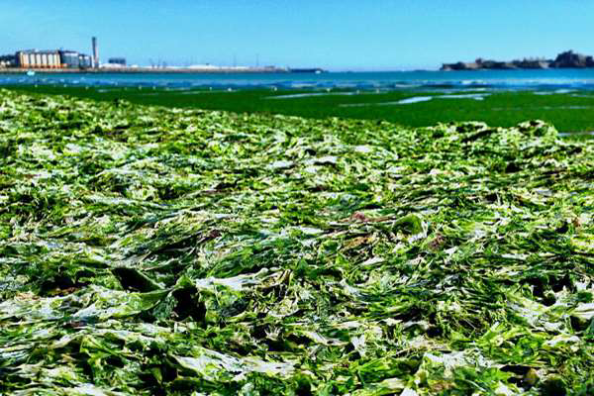 Surely we all remember this?
Surely we all remember this?
 Sea lettuce at St Aubin's Bay
Sea lettuce at St Aubin's Bay

 Part 2: Heavy metals pollution emanating from the land reclamation areas, and affecting our shellfish .. this could potentially be reaching dangerous levels. Our Ten Year study demonstrates this.
Part 2: Heavy metals pollution emanating from the land reclamation areas, and affecting our shellfish .. this could potentially be reaching dangerous levels. Our Ten Year study demonstrates this.

 Since reclamation began, the dumping of toxic incinerator ash and building material at La Collette and the Waterfront has been causing invisible but serious marine pollution.
Since reclamation began, the dumping of toxic incinerator ash and building material at La Collette and the Waterfront has been causing invisible but serious marine pollution.
 The St Helier foreshore has been used as a junkyard for toxic incinerator ash, and the unregulated dumping of unsorted building materials directly on to the beach or into the sea.
The St Helier foreshore has been used as a junkyard for toxic incinerator ash, and the unregulated dumping of unsorted building materials directly on to the beach or into the sea.
The Waterfront is, in effect, one gigantic toxic waste dump.
 The resulting heavy metals pollution has had a considerable adverse on marine life. Examples follow.
The resulting heavy metals pollution has had a considerable adverse on marine life. Examples follow.

 The Horizon Site
The Horizon Site
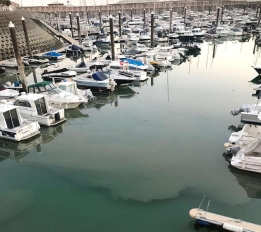

 The Jersey Development Company's Horizon
The Jersey Development Company's Horizon

![]()
 project created 280 apartments and penthouses, a restaurant and retail space. It also gave rise to an enormous tonnage of waste, much of it toxic.
project created 280 apartments and penthouses, a restaurant and retail space. It also gave rise to an enormous tonnage of waste, much of it toxic.

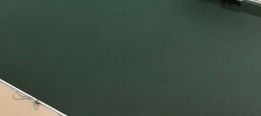 As a result of the absence of proper planning and regulation, in March 2019, leachate of suspended solids from this waste contaminated Elizabeth Marina and on the tide, out to sea.
As a result of the absence of proper planning and regulation, in March 2019, leachate of suspended solids from this waste contaminated Elizabeth Marina and on the tide, out to sea.


 Under the terms of the
Under the terms of the 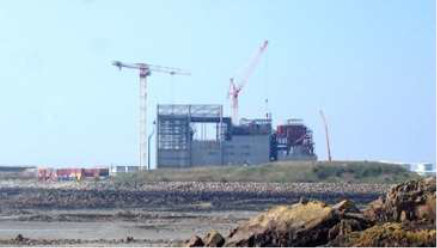 Ramsar agreement, the States of Jersey was obliged to notify Ramsar that it was going to construct the island's new incinerator a few metres from the edge of the Ramsar Area, but failed to The incinerator under construction; the do so. early ash mounds are on the right, rusting
Ramsar agreement, the States of Jersey was obliged to notify Ramsar that it was going to construct the island's new incinerator a few metres from the edge of the Ramsar Area, but failed to The incinerator under construction; the do so. early ash mounds are on the right, rusting
containers containing asbestos on the left Photo: SOS Jersey, 10 April 2010

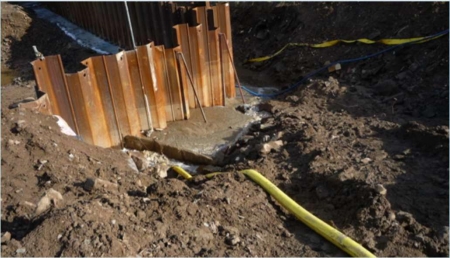
 In March 2009, thousands of tonnes of contaminated leachate were pumped out of the foundations of the excavated pit of the new incinerator into the sea.
In March 2009, thousands of tonnes of contaminated leachate were pumped out of the foundations of the excavated pit of the new incinerator into the sea.
 The plant abuts the south-east coast Ramsar Area; once again, the States of Jersey failed to report this serious pollution event
The plant abuts the south-east coast Ramsar Area; once again, the States of Jersey failed to report this serious pollution event
 in contravention of its agreement. AvPihbaoottvhoee:: ScCoOooSnl tiJnreagrcstceouyrl,sv 2 ei0lrlte0bg9eallloyn pg uinmgp t eod J tEoCxi(cn olewa cJhearsteey i nEtloe ct threic iRtya )msar area of La Collette
in contravention of its agreement. AvPihbaoottvhoee:: ScCoOooSnl tiJnreagrcstceouyrl,sv 2 ei0lrlte0bg9eallloyn pg uinmgp t eod J tEoCxi(cn olewa cJhearsteey i nEtloe ct threic iRtya )msar area of La Collette
 This photo taken in 2011 shows a harmless dye being used in excess by the
This photo taken in 2011 shows a harmless dye being used in excess by the 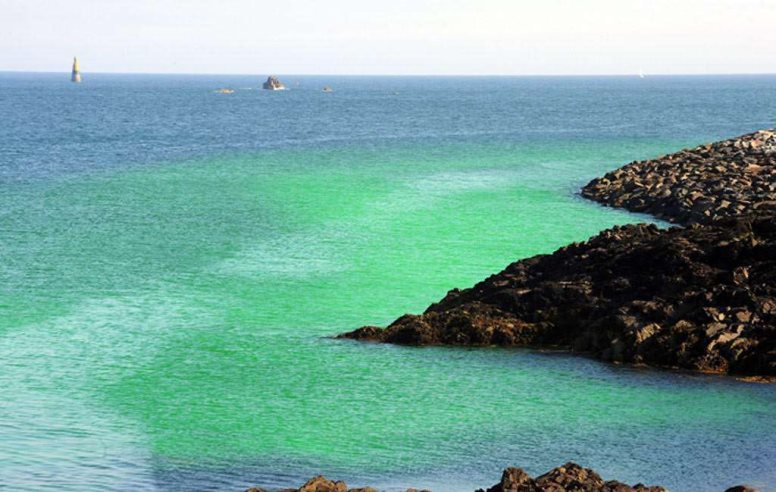 JEC whilst determining the flow of water through their cooling system.
JEC whilst determining the flow of water through their cooling system.


 Don't forget
Don't forget

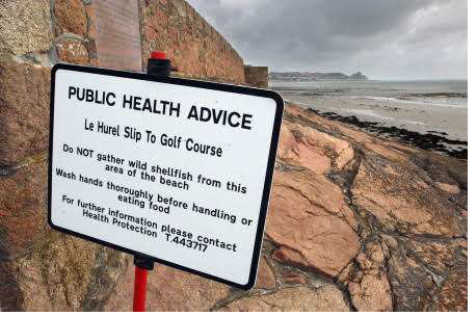 In addition to these major pollution events, there is ongoing contamination on a daily basis affecting our coastal waters and everything trying to live in it.
In addition to these major pollution events, there is ongoing contamination on a daily basis affecting our coastal waters and everything trying to live in it.

 These events are having a cumulative and damaging effect, not only on marine life, but also the people who rely on its success to make a living.
These events are having a cumulative and damaging effect, not only on marine life, but also the people who rely on its success to make a living.
 SOS Jersey carried out two shellfish studies in 2009 and 2019.
SOS Jersey carried out two shellfish studies in 2009 and 2019.

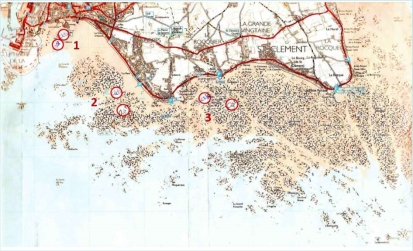
 The three species chosen were the Pacific oyster, common cockle, and common slipper limpet; they are all good indicators of the purity of seawater.
The three species chosen were the Pacific oyster, common cockle, and common slipper limpet; they are all good indicators of the purity of seawater.
To ensure accuracy and relevance, the testing points, tides, times were replicated as accurately as possible.
 All samples were sent to the States Collection points:
All samples were sent to the States Collection points:
Analyst's department for testing. 1: La Collette/Havre des Pas; 2: Green Island; 3: Le Hocq.
(Map courtesy of Christian Guest)

 Bottom feeding shellfish were chosen; although they purify seawater and remove excess nitrates, they absorb metals such as zinc, copper and lead and these elements are found in their flesh.
Bottom feeding shellfish were chosen; although they purify seawater and remove excess nitrates, they absorb metals such as zinc, copper and lead and these elements are found in their flesh.
Shellfish retain heavy metals, and over time, these metals may accumulate to dangerous levels,
 when they are ingested by tSoO cSo lJl ee rcst e sya mMpelmesb aetr sL ean HdoHcqa,uJtulileyu2s0t1u9dents prepare humans. (Photo: SOS Jersey)
when they are ingested by tSoO cSo lJl ee rcst e sya mMpelmesb aetr sL ean HdoHcqa,uJtulileyu2s0t1u9dents prepare humans. (Photo: SOS Jersey)
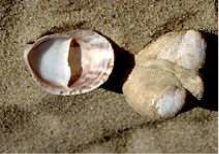

 In the wild, these shellfish become part of the food chain and are eaten by wading birds and many species of fish and crustacea.
In the wild, these shellfish become part of the food chain and are eaten by wading birds and many species of fish and crustacea.

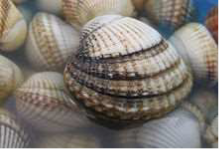 The common cockle particularly plays a major role as a source of food for crustaceans, fish and wading birds.
The common cockle particularly plays a major role as a source of food for crustaceans, fish and wading birds.
 In the Ramsar Area, oysters, cockles and mussels are collected directly from the beach by low water fishermen and eaten without Pacific Oyster being treated. Slipper Limpet Common Cockle
In the Ramsar Area, oysters, cockles and mussels are collected directly from the beach by low water fishermen and eaten without Pacific Oyster being treated. Slipper Limpet Common Cockle
(Photos: Commons)
 Ten Year Survey Results
Ten Year Survey Results
 The shellfish sampled at
The shellfish sampled at  Havre des Pas, Green Island and Le Hocq, were tested for the presence of
Havre des Pas, Green Island and Le Hocq, were tested for the presence of
 • Cadmium
• Cadmium
• Lead
• Copper
• Zinc The results, above, as revealed by
 • Chromium the States Analyst and presented in
• Chromium the States Analyst and presented in
• Arsenic a spreadsheet by SOS Jersey
 Ten Year Survey Findings
Ten Year Survey Findings

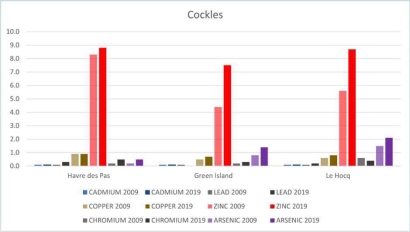 • There was been a marked elevation of heavy metals in the majority of shellfish between 2009 and 2019.
• There was been a marked elevation of heavy metals in the majority of shellfish between 2009 and 2019.
 • There was a marked reduction in numbers and varieties of some species over the decade; no slipper limpets could be found to test at either Green Island or Le Hocq.
• There was a marked reduction in numbers and varieties of some species over the decade; no slipper limpets could be found to test at either Green Island or Le Hocq.
• In 2019 SOS Jersey counselled that as a result of these findings, there should
be ongoing and stringent monitoring and measurement of shellfish
 contamination, particularly in the areas Cockles in particular showed a significant of high risk identified, with all the increase in the presence of heavy metals results being made public. over the ten year period
contamination, particularly in the areas Cockles in particular showed a significant of high risk identified, with all the increase in the presence of heavy metals results being made public. over the ten year period


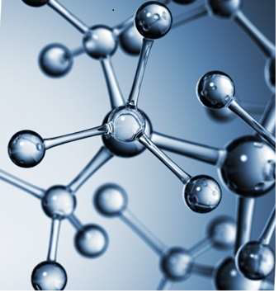

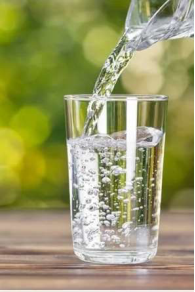 Part 3: PFAS
Part 3: PFAS

 PFAS. Even if you have not heard of them, the chances are you have them inside you.
PFAS. Even if you have not heard of them, the chances are you have them inside you.
 PFAS (Per- and polyfluorinated alkyl substances), also known as the Forever Chemicals', are a large chemical family of over 12,000 diverse and highly persistent substances that do not occur in
PFAS (Per- and polyfluorinated alkyl substances), also known as the Forever Chemicals', are a large chemical family of over 12,000 diverse and highly persistent substances that do not occur in
nature.
 They earned their nickname because they are persistent; they not only survive for a very long time without breaking down, they have the worrying ability to accumulate within living organisms, particularly humans, where their half life is calculated in years.
They earned their nickname because they are persistent; they not only survive for a very long time without breaking down, they have the worrying ability to accumulate within living organisms, particularly humans, where their half life is calculated in years.
 This means that even low levels of exposure can build over time to a point where they become harmful.
This means that even low levels of exposure can build over time to a point where they become harmful.

 These persistent chemicals, give rise to human health concerns, include liver damage, thyroid disease, testicular cancer and reduced response to vaccines.
These persistent chemicals, give rise to human health concerns, include liver damage, thyroid disease, testicular cancer and reduced response to vaccines.
 One of the uses of these substances, and the one that concerns us here, is in fire fighting foam and fire retardants.
One of the uses of these substances, and the one that concerns us here, is in fire fighting foam and fire retardants.
 Due to their weekly use in fire drill practice at the airport in the early 1980s, a vast accumulation of PFAS soaked into the soil and spread into a massive plume infiltrating the aquifer below St Ouen's Bay.
Due to their weekly use in fire drill practice at the airport in the early 1980s, a vast accumulation of PFAS soaked into the soil and spread into a massive plume infiltrating the aquifer below St Ouen's Bay.

 Water from heavily PFAS contaminated Jersey Water boreholes nearby, together with water from a polluted catchment area, continues to be pumped into a primary source for the Island's mains water supply, Val de la Mare reservoir, and subsequently, via the central treatment works to every mains outlet in the Island.
Water from heavily PFAS contaminated Jersey Water boreholes nearby, together with water from a polluted catchment area, continues to be pumped into a primary source for the Island's mains water supply, Val de la Mare reservoir, and subsequently, via the central treatment works to every mains outlet in the Island.

 Many residents had drunk contaminated water from private boreholes for years and when the pollution of their boreholes was discovered, the airport offered to pay for connection to mains water, little realising that this too was now contaminated with PFAS.
Many residents had drunk contaminated water from private boreholes for years and when the pollution of their boreholes was discovered, the airport offered to pay for connection to mains water, little realising that this too was now contaminated with PFAS.
 Some of the residents developed a range of worrying and serious illnesses. Despite pleas for help they were left to pay for their own blood tests at considerable expense. The Government finally agreed to fund the cost of such testing for 78 islanders late in 2022.
Some of the residents developed a range of worrying and serious illnesses. Despite pleas for help they were left to pay for their own blood tests at considerable expense. The Government finally agreed to fund the cost of such testing for 78 islanders late in 2022.
63 of the 78 tested had a higher level of PFAS in their blood, than the vast majority (95%) of a random population sample would have.
 Despite this diluted PFAS contaminated water continues to be pumped into the mains supply serving the whole Island.
Despite this diluted PFAS contaminated water continues to be pumped into the mains supply serving the whole Island.

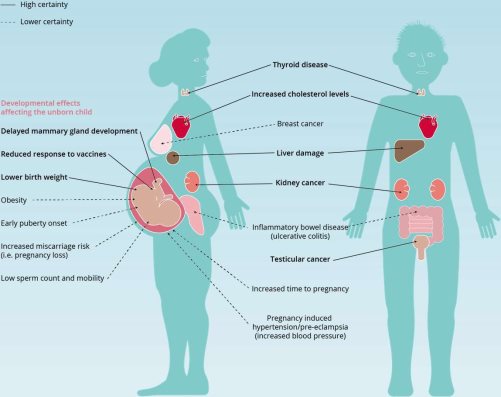 Independent research links PFAS to cancer, birth defects, liver disease, decreased immunity, kidney disease, higher cholesterol and a range of other serious health effects.
Independent research links PFAS to cancer, birth defects, liver disease, decreased immunity, kidney disease, higher cholesterol and a range of other serious health effects.
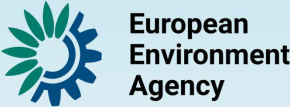

 2019
2019

 While monitoring continues, so does the presence of PFAS. Costly soil remediation is years overdue.
While monitoring continues, so does the presence of PFAS. Costly soil remediation is years overdue.
 Runoff from farmland, streams, outfalls, water from boreholes and mains water from the reservoirs; these must be factored in as threats to the marine environment, because all this pollution finally arrives in our inshore waters.
Runoff from farmland, streams, outfalls, water from boreholes and mains water from the reservoirs; these must be factored in as threats to the marine environment, because all this pollution finally arrives in our inshore waters.
Once more, our marine environment suffers, alongside our population.

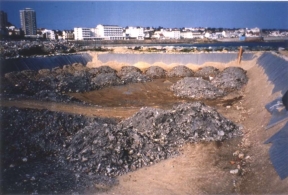
 Part 4: Pollution of the Ramsar Area
Part 4: Pollution of the Ramsar Area
 and the failure to fulfil contractual obligations
and the failure to fulfil contractual obligations

 Jersey is party to the Ramsar
Jersey is party to the Ramsar 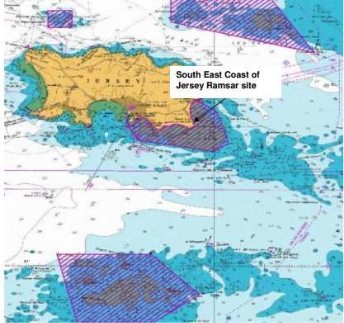 Convention; an intergovernmental treaty which came into being in 1971, for the conservation and wise use of wetlands and their
Convention; an intergovernmental treaty which came into being in 1971, for the conservation and wise use of wetlands and their

 resources. Worldwide there are 1,888 wetland sites, designated for inclusion in the Ramsar List of Wetlands of International Importance. Jersey is privileged to have four of these sites, one being Image taken from the report by PML Applications Limited, its south east coast. caonmd mthies sWioanteedrf rboyntthEenPtelarnpnriisnegBaonadr dE n2v0i0ro9nment Department
resources. Worldwide there are 1,888 wetland sites, designated for inclusion in the Ramsar List of Wetlands of International Importance. Jersey is privileged to have four of these sites, one being Image taken from the report by PML Applications Limited, its south east coast. caonmd mthies sWioanteedrf rboyntthEenPtelarnpnriisnegBaonadr dE n2v0i0ro9nment Department

 All of the pollution events noted in this report have impacted on the Ramsar area to a greater or lesser degree. We have to realise that we are honoured to have been granted Ramsar status for our south east coast and have a duty of care.
All of the pollution events noted in this report have impacted on the Ramsar area to a greater or lesser degree. We have to realise that we are honoured to have been granted Ramsar status for our south east coast and have a duty of care.
 In direct contravention of the terms of the Ramsar Convention, our Government has failed to report these incidents.
In direct contravention of the terms of the Ramsar Convention, our Government has failed to report these incidents.
 Flouting the terms of the agreement in this way is an international ecological disgrace.
Flouting the terms of the agreement in this way is an international ecological disgrace.



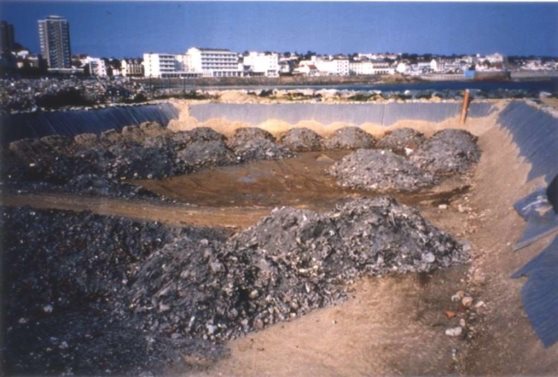 One of the original pits, directly below the incinerator, lined with a thin membrane layer. Further pits to the south are now 'superfilled' (one on top of each other) to a height of 30m, without any planning consent – and are now illegally being raised still further, despite the current Planning Panel's objections. The old lower pits slowly leach heavy metals from the bottom into the Ramsar Area, south-east coast.
One of the original pits, directly below the incinerator, lined with a thin membrane layer. Further pits to the south are now 'superfilled' (one on top of each other) to a height of 30m, without any planning consent – and are now illegally being raised still further, despite the current Planning Panel's objections. The old lower pits slowly leach heavy metals from the bottom into the Ramsar Area, south-east coast.
(Photo: Environment Department)

 That these facts are recognised when drawing up the Marine Spatial Plan, and that steps are taken to ensure that our grandchildren inherit a healthy coastal ecosystem, is of paramount importance.
That these facts are recognised when drawing up the Marine Spatial Plan, and that steps are taken to ensure that our grandchildren inherit a healthy coastal ecosystem, is of paramount importance.
 Perhaps measures will be put in place to see progress in our children's lifetime, if we all make our feelings known?
Perhaps measures will be put in place to see progress in our children's lifetime, if we all make our feelings known?
 Before we can move forward with the Marine Spatial Plan, we have to acknowledge the damage already caused.
Before we can move forward with the Marine Spatial Plan, we have to acknowledge the damage already caused.
 Part 5: Asbestos
Part 5: Asbestos

 Rusting shipping containers of asbestos waste 2015
Rusting shipping containers of asbestos waste 2015


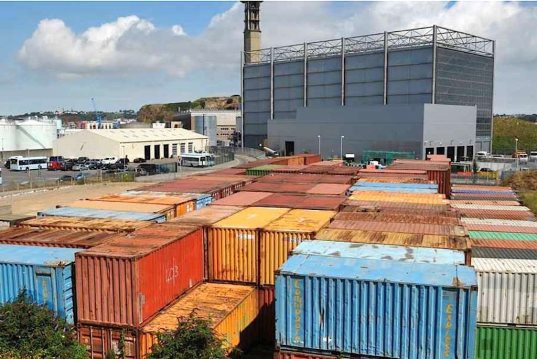 The contents are now buried in sealed pits, following a campaign by SOS Jersey to have them removed from the headland.
The contents are now buried in sealed pits, following a campaign by SOS Jersey to have them removed from the headland.
(photo JEP)
 The Basics – what is asbestos?
The Basics – what is asbestos?
Asbestos is a mineral fibre that occurs naturally in some rock formations.
 It was in the late 1870s that the use of the material started, mainly on ships, steam engines and in power generating plants.
It was in the late 1870s that the use of the material started, mainly on ships, steam engines and in power generating plants.
 It resists heat, fire and acid; and because of these properties, this wonder product' became used in a wide range of building products, including insulation, roofing shingles, ceiling and floor tiles and more.
It resists heat, fire and acid; and because of these properties, this wonder product' became used in a wide range of building products, including insulation, roofing shingles, ceiling and floor tiles and more.
 Between the 1920s and around 1980, millions of tons were mined, and refined asbestos became widely used in the construction of homes, schools and public buildings, mainly for insulation and fireproofing. Its use probably peaked from the 1960s.
Between the 1920s and around 1980, millions of tons were mined, and refined asbestos became widely used in the construction of homes, schools and public buildings, mainly for insulation and fireproofing. Its use probably peaked from the 1960s.
 Asbestos does not pose health risks unless it deteriorates and becomes crumbly, when it can release microscopic asbestos fibres into the air. This is highly likely to during repair or renovation of asbestos-containing structures. Asbestos fibres have a rough texture. They can break into microscopic pieces and are easily transported on clothing, hair and skin.
Asbestos does not pose health risks unless it deteriorates and becomes crumbly, when it can release microscopic asbestos fibres into the air. This is highly likely to during repair or renovation of asbestos-containing structures. Asbestos fibres have a rough texture. They can break into microscopic pieces and are easily transported on clothing, hair and skin.
 When asbestos fibres are inhaled, they can cause chronic health problems to the lungs, throat and gastrointestinal tract, including mesothelioma, that can take as long as five decades to become apparent after exposure.
When asbestos fibres are inhaled, they can cause chronic health problems to the lungs, throat and gastrointestinal tract, including mesothelioma, that can take as long as five decades to become apparent after exposure.
 Any home built or refurbished before 1980 is highly likely to contain what we now know is deadly asbestos, predominantly in walls and roofing constructed with asbestos sheeting - a matrix of cement and asbestos fibres.
Any home built or refurbished before 1980 is highly likely to contain what we now know is deadly asbestos, predominantly in walls and roofing constructed with asbestos sheeting - a matrix of cement and asbestos fibres.
 As these asbestos sheets age, the cement used to hold the asbestos fibres in place deteriorates, and a deadly mix of cement dust and asbestos fibres are carried with the wind into the environment.
As these asbestos sheets age, the cement used to hold the asbestos fibres in place deteriorates, and a deadly mix of cement dust and asbestos fibres are carried with the wind into the environment.
 Even though the dangers of asbestos started becoming known by the early 1990s, it wasn't until 1999 that all types of asbestos were banned in the UK.
Even though the dangers of asbestos started becoming known by the early 1990s, it wasn't until 1999 that all types of asbestos were banned in the UK.

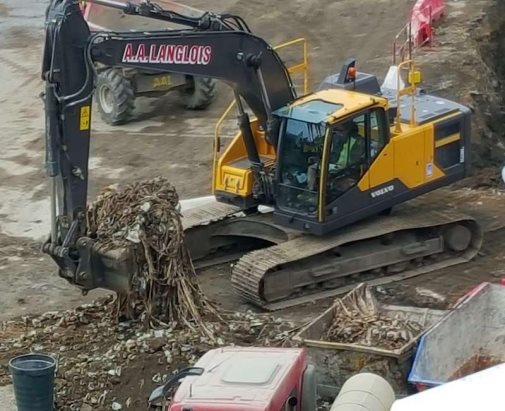 Asbestos waste being dug out from under IFC, the first building of Jersey's International Finance Centre.
Asbestos waste being dug out from under IFC, the first building of Jersey's International Finance Centre.

 Photo: SOS Jersey
Photo: SOS Jersey
There are four main diseases caused by asbestos exposure:
 • Pleural disease: Pleural plaques and pleural thickening are non- cancerous conditions affecting the outer lining of the lungs.
• Pleural disease: Pleural plaques and pleural thickening are non- cancerous conditions affecting the outer lining of the lungs.
• Asbestosis: A chronic respiratory condition; not curable but treatment can prolong survival. People diagnosed with asbestosis have a higher chance of developing asbestos-related cancers.
 • Mesothelioma: This highly aggressive cancer affects up to 10% of people with prolonged exposure to asbestos. Symptoms do not appear until 20-60 years after exposure, by which time tumours have grown and spread. The average life expectancy for mesothelioma patients is 12 to 22 months.
• Mesothelioma: This highly aggressive cancer affects up to 10% of people with prolonged exposure to asbestos. Symptoms do not appear until 20-60 years after exposure, by which time tumours have grown and spread. The average life expectancy for mesothelioma patients is 12 to 22 months.
 • Lung cancer
• Lung cancer
 Mesothelioma in children
Mesothelioma in children
 Mesothelioma is fortunately extremely rare in children and young adults, not because they are immune, but simply because the cancer typically takes decades to develop after exposure to asbestos.
Mesothelioma is fortunately extremely rare in children and young adults, not because they are immune, but simply because the cancer typically takes decades to develop after exposure to asbestos.
 There is a tragic case history of children being exposed in the former asbestos mining town of Wittenoom, Western Australia. Over the course of 23 years, up to 9,000 children, including 2,000 under 15s, were exposed to asbestos pollution, spread over gardens and playing fields.
There is a tragic case history of children being exposed in the former asbestos mining town of Wittenoom, Western Australia. Over the course of 23 years, up to 9,000 children, including 2,000 under 15s, were exposed to asbestos pollution, spread over gardens and playing fields.
 Mining ceased in 1966, but the tragic aftermath was just beginning. Even if the children left the town, the asbestos fibres they inhaled went with them. They led seemingly healthy lives for up to 50 years before the onset of shortness of breath signalled their first symptoms. To date, more than 2,000 workers and residents of Wittenoom have died from asbestos-related diseases.
Mining ceased in 1966, but the tragic aftermath was just beginning. Even if the children left the town, the asbestos fibres they inhaled went with them. They led seemingly healthy lives for up to 50 years before the onset of shortness of breath signalled their first symptoms. To date, more than 2,000 workers and residents of Wittenoom have died from asbestos-related diseases.
 .
.
 How does a remote town in Australia fifty years ago affect us? Here in Jersey in our enlightened times of knowing the risks posed by asbestos?
How does a remote town in Australia fifty years ago affect us? Here in Jersey in our enlightened times of knowing the risks posed by asbestos?
During 2015, nursery groups walked past the IFC site daily whilst harmful asbestos waste mixed with toxic incinerator ash was being excavated a few metres away.
 Pleas by SOS Jersey to have the site properly contained by plastic sheeting were rejected by SoJDC. They were rejected out of hand by an Environmental Health Regulator, 7 September 2015:
Pleas by SOS Jersey to have the site properly contained by plastic sheeting were rejected by SoJDC. They were rejected out of hand by an Environmental Health Regulator, 7 September 2015:
 "I would happily let my own child walk past the site and she has done so on numerous occasions recently."
"I would happily let my own child walk past the site and she has done so on numerous occasions recently."
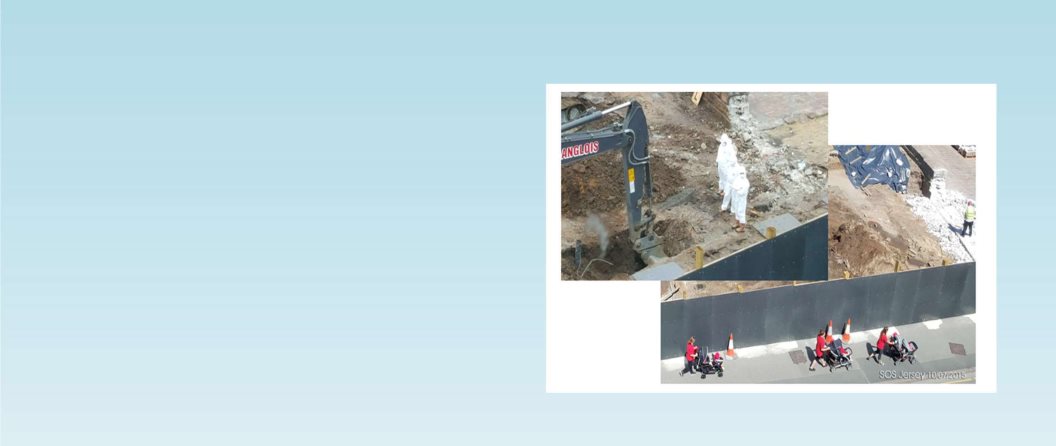 On one side of the fence are Health and Safety conscious workers in full hazmat suits; on the other, nursery nurses push their tiny charges, totally unaware.
On one side of the fence are Health and Safety conscious workers in full hazmat suits; on the other, nursery nurses push their tiny charges, totally unaware.
I truly hope you will not forget
these images taken on the same
day; they will probably haunt
you as they have done me since
I first saw them. It makes me
 wonder; were these children Photo: SOS Jersey identified? Has their health been
wonder; were these children Photo: SOS Jersey identified? Has their health been
monitored? Does anyone care?
 Why has this situation arisen?
Why has this situation arisen?
• It appears that those with the power to take action fail to do so; if that is the case, they are failing in their roles
 • There is sadly no independent regulation to ensure that the relevant authorities fulfil their legal obligations
• There is sadly no independent regulation to ensure that the relevant authorities fulfil their legal obligations
 • There exists a historical lack of investment in our Infrastructure; and we have an ever increasing population with no upper limit
• There exists a historical lack of investment in our Infrastructure; and we have an ever increasing population with no upper limit
• There is a lack of innovative thinking by the relevant departments, whilst they ignore expert external advice freely offered
 Those of us who care about the health of our population and our island's environment can only look on in despair
Those of us who care about the health of our population and our island's environment can only look on in despair

 Thank you for your attention
Thank you for your attention
 If you would like to find out more about the work we do, or if you feel you would like to help, email us at jerseyinperil@gmail.com
If you would like to find out more about the work we do, or if you feel you would like to help, email us at jerseyinperil@gmail.com
